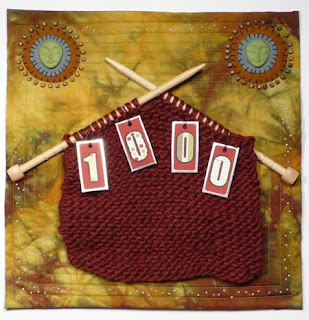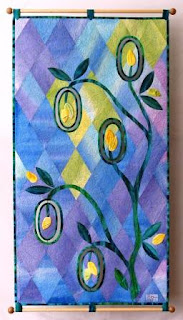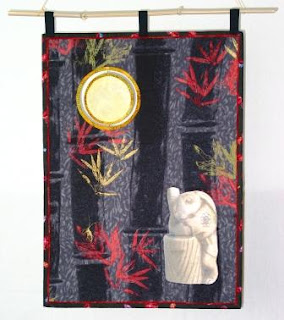 Does Nadine Ruggles need an intervention?
Does Nadine Ruggles need an intervention? I think Inchies have taken over her life! But that's a good thing -- at least for us.
Her new book Inchie Quilts published by AQS Publishing can cause addiction -- so read with caution. Just kidding. It certainly sparks the imagination for big ideas in tiny tiny spaces.
Back in the day the 'in thing' for frugal and imaginative quilters resulted in scrap quilts entirely pieced in one-inch squares. My husband's grandmother was a master at these perfectly pieced wonders. She would be the first one to examine Nadine's twist on the use of that little square.
Nadine's Elemental Changes--Color Play (pictured above) reflects a similar romance with that little square. But as Nadine explains -- each Inchie is complete in itself. Yep, each little square on this quilt is actually one finished Inchie. I'm fascinated with her fascination with Inchies! -- Dawn
Note: Elemental Changes--Color Play was made for the New Quilts from an Old Favorite Contest sponsored by the National Quilt Museum, and is published in the book Burgoyne Surrounded -- New Quilts from an Old Favorite. More info about the cont est here.
est here.
WIN A FREE COPY OF NADINE'S BOOK! What will you use to create a world on your Inchies? Get creative and tell me what kind of materials you’ll use to create a dimensional story on your Inchies, and be entered to win your own copy of Inchie Quilts! (One winner will be chosen; deadline to enter is Aug. 30, 2009.)
 est here.
est here.WIN A FREE COPY OF NADINE'S BOOK! What will you use to create a world on your Inchies? Get creative and tell me what kind of materials you’ll use to create a dimensional story on your Inchies, and be entered to win your own copy of Inchie Quilts! (One winner will be chosen; deadline to enter is Aug. 30, 2009.)
Have you seen Inchies?
Guest Blog by Nadine Ruggles in her own words.
Fabric artists make Inchies, these 1-inch by 1-inch fabric or paper art squares, in the same way postcards and ATCs are made. They use fabric,
 batting, and perhaps a stiffener, and embellish them with beads, buttons, crystals, fibers, wire, and found objects.
batting, and perhaps a stiffener, and embellish them with beads, buttons, crystals, fibers, wire, and found objects. When I saw Inchies for the first time, I thought, “Wow! That’s pretty cool, but so small!" I turned and twisted, examined its tiny frame and wondered, "How can you make an interesting design in so small a space?” Then life intruded and I forgot Inchies for a while.
Later, I needed to take a break from a couple of large projects, and decided to make some Inchies, just for the heck of it. Maybe you’ve even made some and swapped them with other textile artists. If so, you’ll probably understand when I tell you I was instantly addicted to Inchies. Even now one of those large projects, which I took a break from, still lies in an unfinished state totally preempted by the Inchie Invasion.
The other large project is finished, but only because I decided to incorporate Inchies into the quilt; 500 and then some Inchies later, it became one of the first Inchie Quilts.
What is it about these exquisite little gems that is so attractive and intriguing?
What is it about these exquisite little gems that is so attractive and intriguing?
How can you make an interesting design in just one square inch of space? Start with the fabric.
Look for a fabric with interesting design elements in colors that you fancy. Find a fabric  you love, and then use some coordinating threads in different colors, textures and weights to add some base texture with machine quilting. And then the real fun begins. Gather anything and everything you think you might use to create a little design story on your Inchie.
you love, and then use some coordinating threads in different colors, textures and weights to add some base texture with machine quilting. And then the real fun begins. Gather anything and everything you think you might use to create a little design story on your Inchie.
Beads are perfect of course, and crystals, tiny buttons, and bits of lace or chunky fibers are naturals for Inchie embellishments. But let your mind and imagination wander, and look for other things like safety pins, computer parts, colored copper wire, felt shapes, watch parts, jewelry findings, shells, small stones; anything and everything that can be glued or sewn on or stuck through is fair game for Inchie embellishments, as long as you keep the diminutive nature of the Inchie canvas in mind. This is where you can use that ever-growing stash of bead mixes and fiber bundles, as well as all the found objects and odd bits and bobs that you may wonder why you kept, but couldn’t bear to part with.
other things like safety pins, computer parts, colored copper wire, felt shapes, watch parts, jewelry findings, shells, small stones; anything and everything that can be glued or sewn on or stuck through is fair game for Inchie embellishments, as long as you keep the diminutive nature of the Inchie canvas in mind. This is where you can use that ever-growing stash of bead mixes and fiber bundles, as well as all the found objects and odd bits and bobs that you may wonder why you kept, but couldn’t bear to part with.
 you love, and then use some coordinating threads in different colors, textures and weights to add some base texture with machine quilting. And then the real fun begins. Gather anything and everything you think you might use to create a little design story on your Inchie.
you love, and then use some coordinating threads in different colors, textures and weights to add some base texture with machine quilting. And then the real fun begins. Gather anything and everything you think you might use to create a little design story on your Inchie.Beads are perfect of course, and crystals, tiny buttons, and bits of lace or chunky fibers are naturals for Inchie embellishments. But let your mind and imagination wander, and look for
 other things like safety pins, computer parts, colored copper wire, felt shapes, watch parts, jewelry findings, shells, small stones; anything and everything that can be glued or sewn on or stuck through is fair game for Inchie embellishments, as long as you keep the diminutive nature of the Inchie canvas in mind. This is where you can use that ever-growing stash of bead mixes and fiber bundles, as well as all the found objects and odd bits and bobs that you may wonder why you kept, but couldn’t bear to part with.
other things like safety pins, computer parts, colored copper wire, felt shapes, watch parts, jewelry findings, shells, small stones; anything and everything that can be glued or sewn on or stuck through is fair game for Inchie embellishments, as long as you keep the diminutive nature of the Inchie canvas in mind. This is where you can use that ever-growing stash of bead mixes and fiber bundles, as well as all the found objects and odd bits and bobs that you may wonder why you kept, but couldn’t bear to part with. Once you’ve gathered your embellishments and have many to choose from, spend some t ime selecting a variety of embellishments to use. Choose a mixture of shapes and sizes, colors and finishes. Start by building up the embellishments in layers. Add some simple embroidery stitches with metallic thread or hand-dyed flosses to accent the fabric design or the quilting or both. Use a large bead or button as a focal point, and place smaller beads or crystals or findings around it to create a multidimensional texture and design story in just one square inch.
ime selecting a variety of embellishments to use. Choose a mixture of shapes and sizes, colors and finishes. Start by building up the embellishments in layers. Add some simple embroidery stitches with metallic thread or hand-dyed flosses to accent the fabric design or the quilting or both. Use a large bead or button as a focal point, and place smaller beads or crystals or findings around it to create a multidimensional texture and design story in just one square inch.
 ime selecting a variety of embellishments to use. Choose a mixture of shapes and sizes, colors and finishes. Start by building up the embellishments in layers. Add some simple embroidery stitches with metallic thread or hand-dyed flosses to accent the fabric design or the quilting or both. Use a large bead or button as a focal point, and place smaller beads or crystals or findings around it to create a multidimensional texture and design story in just one square inch.
ime selecting a variety of embellishments to use. Choose a mixture of shapes and sizes, colors and finishes. Start by building up the embellishments in layers. Add some simple embroidery stitches with metallic thread or hand-dyed flosses to accent the fabric design or the quilting or both. Use a large bead or button as a focal point, and place smaller beads or crystals or findings around it to create a multidimensional texture and design story in just one square inch. While you’re making this first Inchie, you’ll probably get ideas about how to embellish the next one, and the next, and the next one after that. At some point, you may find yourself stumped by how to embellish a particular Inchie, but you’ll get even more creative to solve that little design dilemma, and be excited and eager to move on to the next one.
While you’re making this first Inchie, you’ll probably get ideas about how to embellish the next one, and the next, and the next one after that. At some point, you may find yourself stumped by how to embellish a particular Inchie, but you’ll get even more creative to solve that little design dilemma, and be excited and eager to move on to the next one.As you create more and more Inchies, you’ll realize that each one has something to say and a story to tell, but it’s when they get together in groups that they speak the loudest. There’s a tiny world full of details and textural interest in each one, and when you put them all together they become a universe of creative possibilities. Inchies are more than just patchwork and you’ll want to take your time and study each one to see inside its world.
Accessorize Me—with Inchies! (pictured below) was awarded an Honorable Mention ribbon at the National Quilting Association Quilt Show in Columbus, Ohio in June. This quilt will be on display at the IQA World of Beauty Quilt Show at the Fall Quilt Market and Fall Quilt Festival in Houston, October 10-12 and 15-18 respectively.
To see a world in one square inch every day, subscribe to The Daily Inchie. A new Inchie is profiled every day and delivered to you via RSS feed or email. Visit InchieQuilts.com to find more information and download extra content for the book, along with news and updates about Inchie Quilts and upcoming workshops and lectures. Order your copy of Inchie Quilts at  DreamWeaver’s Quilts Studio, where you will also find unique supplies and embellishments.
DreamWeaver’s Quilts Studio, where you will also find unique supplies and embellishments.
 DreamWeaver’s Quilts Studio, where you will also find unique supplies and embellishments.
DreamWeaver’s Quilts Studio, where you will also find unique supplies and embellishments. Thank you, Dawn, for inviting me to be a guest here at Subversive Stitchers! -- Nadine
BIO: Nadine Ruggles has been sewing and crafting since childhood, and was caught by the quilting bug in 1990. She wanted to make "just one (large) quilt" for the bed and, of course, couldn't stop quilting after that. Being mostly self-taught, Nadine sees each new q uilt as a challenge, and she applies her special talents for fabric selection, precision piecing, elegant quilting and unexpected embellishments to traditional blocks to create innovative quilt art pieces. Nadine lives in Angelbachtal, Germany, with her husband Eric and two beautiful daughters, Erica and Erin. She has been the recipient of numerous awards for her machine quilting and innovative piecing. Her quilts have been exhibited across the United States in quilt shows, galleries and museums, and her newest work and techniques are featured in Inchie Quilts, published by the American Quilter's Society. Nadine will be teaching Inchie Quilts and other embellishment workshops at the AQS Quilt Expo Des Moines in October, 2009.
uilt as a challenge, and she applies her special talents for fabric selection, precision piecing, elegant quilting and unexpected embellishments to traditional blocks to create innovative quilt art pieces. Nadine lives in Angelbachtal, Germany, with her husband Eric and two beautiful daughters, Erica and Erin. She has been the recipient of numerous awards for her machine quilting and innovative piecing. Her quilts have been exhibited across the United States in quilt shows, galleries and museums, and her newest work and techniques are featured in Inchie Quilts, published by the American Quilter's Society. Nadine will be teaching Inchie Quilts and other embellishment workshops at the AQS Quilt Expo Des Moines in October, 2009.
Visit with Nadine and find out more about her artwork, book, workshops and lectures at her website and blog, DreamWeaver’s Quilts.
 uilt as a challenge, and she applies her special talents for fabric selection, precision piecing, elegant quilting and unexpected embellishments to traditional blocks to create innovative quilt art pieces. Nadine lives in Angelbachtal, Germany, with her husband Eric and two beautiful daughters, Erica and Erin. She has been the recipient of numerous awards for her machine quilting and innovative piecing. Her quilts have been exhibited across the United States in quilt shows, galleries and museums, and her newest work and techniques are featured in Inchie Quilts, published by the American Quilter's Society. Nadine will be teaching Inchie Quilts and other embellishment workshops at the AQS Quilt Expo Des Moines in October, 2009.
uilt as a challenge, and she applies her special talents for fabric selection, precision piecing, elegant quilting and unexpected embellishments to traditional blocks to create innovative quilt art pieces. Nadine lives in Angelbachtal, Germany, with her husband Eric and two beautiful daughters, Erica and Erin. She has been the recipient of numerous awards for her machine quilting and innovative piecing. Her quilts have been exhibited across the United States in quilt shows, galleries and museums, and her newest work and techniques are featured in Inchie Quilts, published by the American Quilter's Society. Nadine will be teaching Inchie Quilts and other embellishment workshops at the AQS Quilt Expo Des Moines in October, 2009.Visit with Nadine and find out more about her artwork, book, workshops and lectures at her website and blog, DreamWeaver’s Quilts.




















.jpg)